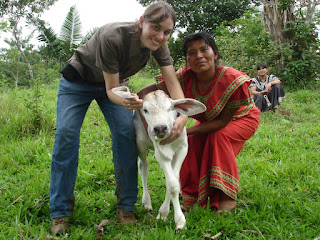 |
| Iguanas, reported to be quite tasty (haven't tried yet) |
Some of my many American traits:
Craving and eating vegetables.
Requiring "alone time" to think and process (a foreign idea to the family-oriented Panamanians).
Reading for fun.
Traveling far away from my loved ones and connections to have an adventure of service and self-discovery in another country.
I feel a new respect for immigrants to the US, as well, who may be coming from a very different context, to a new world with a vast array of options to choose from, of decisions to be made on a daily basis. I and a Volunteer friend were imagining what it would be like for a Ngabe to move to the US. What would they think of us, and how would they manage so far from their family? I think I can never really communicate my US world to them; it's a real privilege to be acquainted with more than one way of life and to share in theirs. Most aspects of Ngabe life are really different from mine in the US: traditional, even ancient in some cases. Other aspects are just the same- many Panamanians have cell phones too, for example. To me, the cell phone feels like an interloper from my other life, something that doesn't belong here with the palm thatch huts and the chickens. But I'm glad that we both have phone access.
I've received some questions about my diet, so I'd like to share a bit of that so-important part of my day. I eat with my host family. We eat rice, fried or boiled bananas, white yams, and yucca. These starches are topped with chicken, egg, greens, instant soup, squash, or beans. I bring dried beans, spices, and vegetables from town every 10-14 days to supplement what the family grows. The family also grows coffee and chocolate, which they prepare and drink themselves or sell informally to neighbors. I'm actually eating a better variety of foods than I did in my training period (a typical meal was rice or spaghetti with chicken in a ketchup sauce). Food for the most part is plentiful but if a meal falls between the cracks I eat from a secret stash of peanut butter and crackers.
Bush Meats I've tried (generous, hunter neighbors)
 |
| Don't worry, this conejo pintado is a pet... I ate a different one. |
Conejo Pintado, or Paca
Wild Boar
Deer
New Fruits & Vegetables in Panama
Nance- small, cherry like fruits with a tart flavor, reminds me of rhubarb
Pifa- palm nuts, dry with a tasty, meaty flavor
Custard Apple- a fruit with oddly gooey, white flesh
Bananas- Some really tasty banana varieties which we don't see in the States.
Chayote- summer squash; you can eat the leaves too.
Zapayo- pumpkin-like squash
Boda- a wild flower, harvested in the woods when it's still in the bud.
Cacao- cacao + water is the traditional, and ritual drink, though coffee is more common everyday now.
I'll close with a few photos:
 |
| The family cow gave birth on Sunday Nov 13. |
 |
| Baby calf, several hours old |
 |
| Making an "organic pesticide" with local teacher & environmentalist Regina and agriculture volunteer Winston |
 |
| Creating a map of the community with a group of men and a group of women, a step in my community analysis |
 |
| Drawing a map with a different section of my community |
 |
| Harvesting coffee with my host family |
 |
| Harvesting my host family's coffee. These are "coffee cherries"- the bean is inside a fleshy fruit |
oooh, new foods! =) i've had cherimoyas before, and i think they're similar to custard apples - so good!!
ReplyDelete<3
for future posts - you know i'm obsessed with food, and i'd be really interested to learn more about the various preparation methods used - is the rice soaked before cooking? how are the yams/yucca prepared? etc.
ReplyDeletelooooooooove you.
Teal, so good to hear from you.
ReplyDeleteMeals in general are starches. The Panamanian diet, nationally, is some 65% carbs- much of which is rice and sugar (info from the PC). With my host family, we usually boil green bananas, yams, yucca, or rice. In a separate pot we may cook a soup of lentils or beans (usually ones that I supply), or vegetables such as homegrown squash or dark leafy greens. I love the dark leafies, known as "jiraca"- they can be young squash leaves or young otoi leaves. Occasionally we buy inexpensive meat- chicken necks, or last week, a big bag of smoked cow intestines and hooves, which made their way into soup. I thought I'd be grossed out by the intestines but they were just really chewy and made a good broth with leafy greens.
My host mom loves to add Maggi instant chicken soup mix to many things... it is pretty yummy, with MSG and all. I supply spices for the kitchen and hot sauce.
Once I get some actual recipes figured out it would be fun to post them.
I think I made a mistake about the "custard apple"- I think it's actually "soursop" or guanabana in Spanish (wikipedia). Similar though...